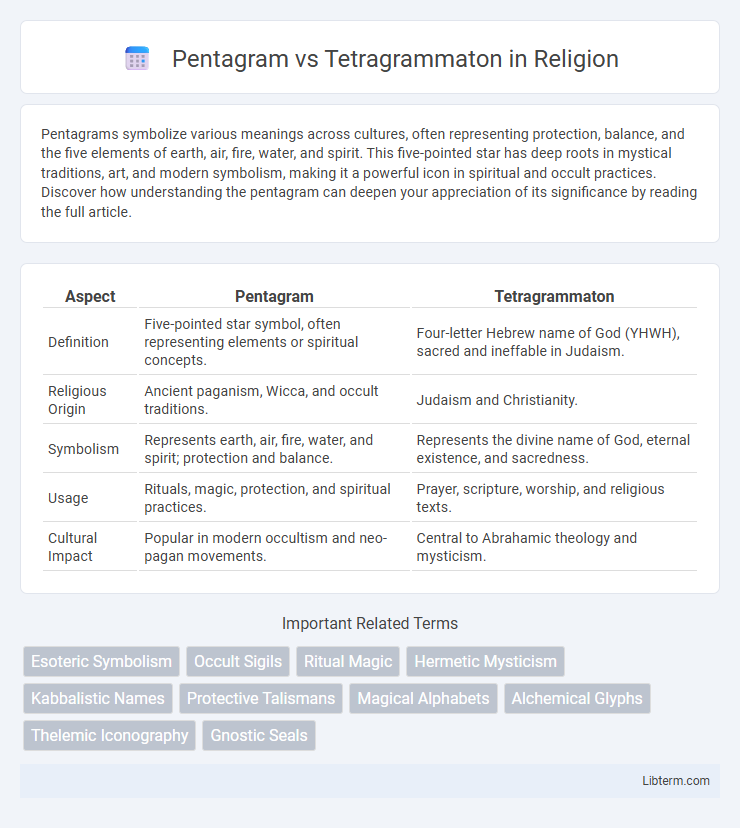Pentagrams symbolize various meanings across cultures, often representing protection, balance, and the five elements of earth, air, fire, water, and spirit. This five-pointed star has deep roots in mystical traditions, art, and modern symbolism, making it a powerful icon in spiritual and occult practices. Discover how understanding the pentagram can deepen your appreciation of its significance by reading the full article.
Table of Comparison
| Aspect | Pentagram | Tetragrammaton |
|---|---|---|
| Definition | Five-pointed star symbol, often representing elements or spiritual concepts. | Four-letter Hebrew name of God (YHWH), sacred and ineffable in Judaism. |
| Religious Origin | Ancient paganism, Wicca, and occult traditions. | Judaism and Christianity. |
| Symbolism | Represents earth, air, fire, water, and spirit; protection and balance. | Represents the divine name of God, eternal existence, and sacredness. |
| Usage | Rituals, magic, protection, and spiritual practices. | Prayer, scripture, worship, and religious texts. |
| Cultural Impact | Popular in modern occultism and neo-pagan movements. | Central to Abrahamic theology and mysticism. |
Introduction to Esoteric Symbols
The pentagram, a five-pointed star, symbolizes protection, balance, and the human microcosm within esoteric traditions, frequently representing the elements and spiritual harmony. The tetragrammaton, consisting of the four Hebrew letters Yod-He-Vav-He (yhvh), represents the ineffable name of God, embodying divine creation and sacred power in Kabbalistic mysticism. Both symbols serve as foundational icons in occult studies, conveying profound metaphysical concepts through their geometric and linguistic forms.
Origins of the Pentagram
The pentagram, a five-pointed star, dates back to ancient Mesopotamia around 3000 BCE, where it symbolized various concepts such as directions and imperial power. Unlike the tetragrammaton, which specifically represents the sacred four-letter name of God in Hebrew tradition, the pentagram has roots in multiple cultures, including Greek and Babylonian symbolism, often associated with protection and the elements. Its geometric design later influenced Pythagorean mathematical mysticism, emphasizing harmony and balance.
History of the Tetragrammaton
The Tetragrammaton, represented by the four Hebrew letters Yod-Heh-Vav-Heh (yhvh), is the biblical name of God central to Jewish tradition and appears extensively in ancient Hebrew texts and the Dead Sea Scrolls. Its origins trace back over 3,000 years, emphasizing the sacred and ineffable nature of the divine name in the Old Testament, often replaced with "Adonai" during reading to avoid pronunciation. This contrasts with the pentagram, a five-pointed star symbol historically connected to paganism, occultism, and later Western esotericism, with no direct scriptural roots in Judeo-Christian texts.
Symbolic Meanings: Pentagram
The pentagram, a five-pointed star, symbolizes balance and protection widely used in pagan and Wiccan traditions to represent the elements of earth, air, fire, water, and spirit. Its pointed design conveys spiritual harmony and the human microcosm, with each point corresponding to a facet of existence. Historically, the pentagram served as a talisman against evil, embodying purity and the interconnectedness of life forces.
Spiritual Significance: Tetragrammaton
The Tetragrammaton, composed of the four Hebrew letters Yod, He, Vav, He (YHWH), represents the ineffable name of God in Judaic tradition, symbolizing divine essence and eternal existence. It holds profound spiritual significance as a sacred and powerful invocation, encapsulating God's omnipresence and creative force in mysticism and Kabbalistic teachings. Unlike the Pentagram, which is often associated with protection, balance, and elements, the Tetragrammaton directly embodies the foundational divine identity central to monotheistic spirituality.
Use in Western Mysticism
The pentagram, a five-pointed star symbolizing balance and protection, is widely used in Western mysticism to represent the elements and human spirit in harmony within esoteric traditions such as Wicca and Hermeticism. The tetragrammaton, represented by the four-letter Hebrew name of God (YHWH), holds profound significance in Kabbalah and Christian mysticism as a symbol of divine authority, creation, and the ineffable nature of God. Both symbols serve as powerful tools in ritual magic and spiritual meditation, highlighting different aspects of the sacred and metaphysical order in Western esoteric practices.
Pentagram in Occult and Rituals
The pentagram, a five-pointed star, holds significant symbolic weight in occult practices and rituals, often representing the elements of earth, air, fire, water, and spirit unified. In magical traditions, it serves as a protective emblem, used in rituals to invoke spiritual energies or to ward off negative forces. Unlike the tetragrammaton, which is a sacred name of God rooted in Hebrew mysticism, the pentagram is a versatile symbol that bridges natural elements and metaphysical concepts within various esoteric systems.
Tetragrammaton in Religious Contexts
The Tetragrammaton, represented by the four Hebrew letters YHWH, holds profound significance in Judeo-Christian religions as the sacred and ineffable name of God, often translating to "I AM" or "the Eternal." Unlike the pentagram, which is predominantly a symbol in occult and pagan traditions, the Tetragrammaton embodies divine authority and is central to scriptural texts, prayer, and religious rituals. Its deep-rooted presence in Torah, Talmud, and Christian liturgy underscores its role as a cornerstone of monotheistic faith and theology.
Comparative Analysis: Pentagram vs Tetragrammaton
The pentagram, a five-pointed star often linked to mysticism and protection, contrasts sharply with the Tetragrammaton, the four-letter Hebrew name of God (YHWH) symbolizing divine authority and sacredness in Judaic tradition. While the pentagram serves as a symbolic icon in various esoteric and pagan contexts, the Tetragrammaton holds profound theological significance, representing the ineffable name of God in biblical texts. This comparative analysis highlights the pentagram's role in spiritual symbolism versus the Tetragrammaton's central function in monotheistic religious identity and scripture.
Contemporary Interpretations and Debates
Contemporary interpretations of the pentagram emphasize its role as a symbol of protection, balance, and the five elements in modern Pagan and Wiccan practices. The tetragrammaton, representing the four-letter name of God (YHWH) in Jewish mysticism, is central to Kabbalistic teachings and is often debated for its sacredness and the implications of its pronunciation. Scholars and practitioners frequently discuss the pentagram's open symbolism versus the tetragrammaton's concealed divine essence, highlighting ongoing debates around ritual use, cultural appropriation, and theological significance.
Pentagram Infographic

 libterm.com
libterm.com